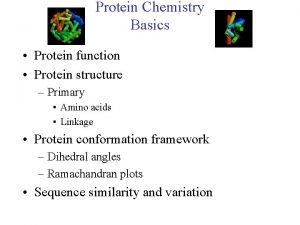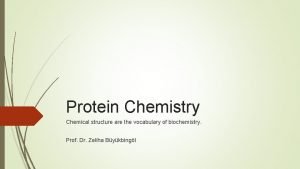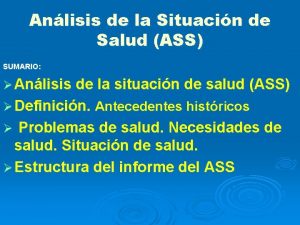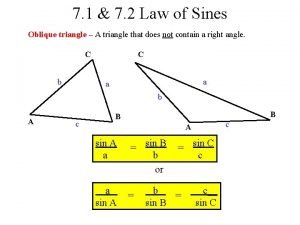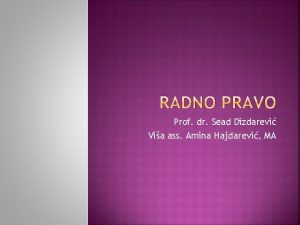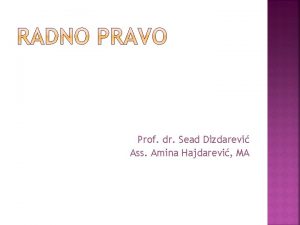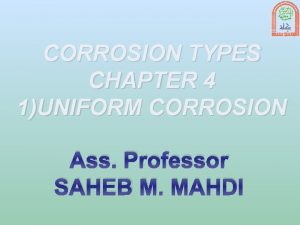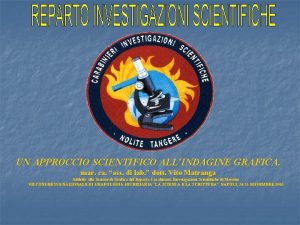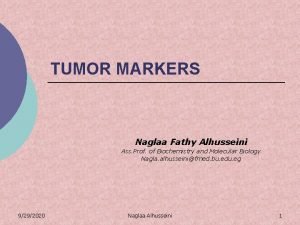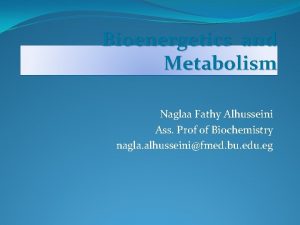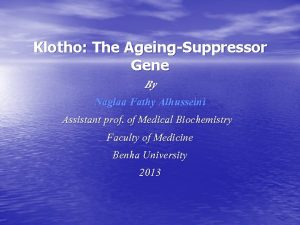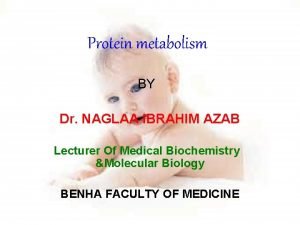Protein Chemistry Ass Prof Naglaa Fathy Alhusseini 11242020






































- Slides: 38

Protein Chemistry Ass. Prof. /Naglaa Fathy Alhusseini 11/24/2020 Naglaa Alhusseini 1

Proteins chemistry o Definition: Proteins are organic nitrogenous compound of high molecular weight, consisting largely or entirely of α-amino acids united together by peptide linkages. They are composed of carbon, hydrogen, oxygen and nitrogen, many types of proteins may contain sulfur. Nitrogen is a characteristic component of proteins, forming about 16% of their weight. 11/24/2020 Naglaa Alhusseini 2

Functions of proteins: o Synthesis of tissue proteins e. g. , contractile protein of muscles, collagen …etc. . . o Synthesis of cell organelles as cell membrane , receptors……. etc o Synthesis of enzymes o Synthesis of milk proteins. o Synthesis of plasma proteins. o Synthesis of protein hormones. o Synthesis of nucleoproteins. 11/24/2020 Naglaa Alhusseini 3

Biological importance of proteins: o n n n Fibrous or structural protein Keratin- elastin Collagen- reticulin Muscle protein (Myocin and Actin) Protein of cell membrane Protein of cytoplasm Functional protein Enzyme Hormones Receptors Igs Plasma protein Hemoglobin 11/24/2020 Naglaa Alhusseini 4

Questions o 1 - What are the biological importance of proteins? o All the following are functional protein EXCEPT A. B. C. D. 11/24/2020 Igs enzyme Collagen Hemoglobin Naglaa Alhusseini 5

Amino Acids o Amino acid is an organic acid containing one or more amino group and carboxylic group (COOH) o carboxylic group (COOH) and amino group (NH 2) are both attached to the α-carbon o They are the building units of protein. 11/24/2020 Naglaa Alhusseini 6

11/24/2020 Naglaa Alhusseini 7

o Amino acids found in proteins are of L-configuration, this means that the amino group to the left and the hydrogen to the right of the a-carbon o D-amino acid o L-amino acid Isomerism of amino acids 11/24/2020 Naglaa Alhusseini 8

Functions of amino acids: Question o Synthesis of structural and functional proteins. o L-amino acid and their derivatives play a role in intracellular functions as nerve impulse transmission and regulation of cell growth. o Biosynthesis of purines, pyrimidines, urea and porphyrins. o L-and D-amino acids are present in polypeptide antibiotics secreted by microorganisms. True or false ? ? 11/24/2020 Naglaa Alhusseini 9

Classifications: Amino acids can be classified by different classification: o o Chemical classification. Nutritional classification. Metabolic classification. Reaction classification (Charge properties). 11/24/2020 Naglaa Alhusseini 10

1. Chemical classification: A) Aliphatic amino acids: have no ring; These amino acids may be subclassified into: n Branched chain amino acids: as valine, leucine, and isoleucine. n Hydroxy amino acids: as serine and threonine. n Sulphur containing amino acids: as cysteine and methionine. n Amino acids with amide group: as asparagine and glutamine. 11/24/2020 Naglaa Alhusseini 11

11/24/2020 Naglaa Alhusseini 12

Glycine Gly - G Alanine Ala - A Val - V Valine Leu – L Leucine Isoleucine Ile - I 13

Serine Ser - S Threonine Thr - T Cysteine Cys - C Methionine Met - M Cystine 11/24/2020 Naglaa Alhusseini 14

Aromatic amino acids Phenylalanine Phe - F Tyrosine Tyr - Y Tryptophan Trp - W 11/24/2020 Naglaa Alhusseini 15

Heterocyclic amino acids: They have heterocyclic ring as histidine, tryptophan, proline and hydroxyproline. Proline Hydroxy proline 11/24/2020 Pro – P Hyp Naglaa Alhusseini 16

Reaction classification ( charge properties): Non polar (Neutral): having equal number of amino and carboxyl groups e. g. alanine, serine, valine …etc o Polar Basic AA: having more than one amino group and one carboxyl e. g. arginine, lysine, histidine …etc o Polar (Acidic): having one amino group and two carboxyl e. g. glutamic acid and aspartic acid o 11/24/2020 Naglaa Alhusseini 17

Polar Basic AA: having more than one amino group and one carboxyl e. g. arginine, lysine, histidine Arginine Arg - R Lysine Lys - K Histidine His - H 11/24/2020 Naglaa Alhusseini 18

Acidic Amino Acids and their Amides Aspartic Acid Asp - D Asparagine Asn - N Glutamic Acid Glu - E Glutamine Gln - Q 11/24/2020 Naglaa Alhusseini 19

B) Aromatic amino acids: They have benzene ring in their side chains like o o o Phenylalanine Tyrosine Tryptophan C) Heterocyclic amino acids: They have heterocyclic ring as o o o Histidine, Tryptophan, Proline and hydroxyproline. 11/24/2020 Naglaa Alhusseini 20

2. Nutritional classification: They are classified into three groups: o Essential amino acids: They are amino acids which cannot be synthesized in the body and must be taken in diet; phenylalanine, methionine, isoleucine, lysine, valine, threonine and tryptophan. o Semi essential amino acids: They are amino acids required in the food of growing children not in the food of adult as histidine and arginine. o Non essential amino acids: can be synthesized inside the body as glycine, alanine, serine, cysteine, cystine, aspartic, tyrosine, glutamic, proline and hydroxyproline 11/24/2020 Naglaa Alhusseini 21

Memory Aid for Essential Amino Acids Any Help In Learning These Little Molecules Proves Truly Valuable Arginine –Histedine – Isoleosine – Leosine – Threonine- Lysine. Methionine –Phyenylalanine. Tryptophan –Valine 11/24/2020 Naglaa Alhusseini 22

3. Metabolic classification: According to their fate in the body they are classified into three groups: o Glucogenic amino acids: give glucose inside the body as glycine, alanine, aspartic and glutamic. o Ketogenic amino acid: gives ketone bodies as leucine. o Glucogenic and ketogenic amino acids: They give both glucose and ketone bodies as lysine, tryptophan, tyrosine, phenylalanine and isoleucine. 11/24/2020 Naglaa Alhusseini 23

Clinical importance of amino acids and their derivatives o o o o o L-tyrosine is sometimes recommended by practitioners as helpful for weight loss, clinical depression. Dopamine derived from tyrosine is a neurotransmitter. Thyroxine is an important thyroid hormone from tyrosine. Gamma aminobutyric acid (GABA) derived from glutamic acid; which is a neurotransmitter. Cycloserine derived from serine is an anti-tuberculous drug. Arginine stimulates the healing of burning wound and other wounds. Arginine together with lysine can limit herpes attacks (bladders in the mouth) for people that carry this virus. Cysteine can help to recover the damage by smoking and alcohol. Glutamine can give the mind new energy and can help to prevent and treat inflammations of the large intestine. 11/24/2020 Naglaa Alhusseini 24

o Which of the following amino acid is an acidic amino acid. n n Arginine Aspartic acid Lysine Leucine 11/24/2020 Naglaa Alhusseini 25

o Which of the following amino acid is both neutral and aromatic in nature? n n Alanine Histidine Plyenylalanine Proline 11/24/2020 Naglaa Alhusseini 26

o All amino acids which both glucogenic and ketogenic are essential amino acids EXCEPT n n Phenylalanine Tyrosine Glycine Alanine 11/24/2020 Naglaa Alhusseini 27

11/24/2020 Naglaa Alhusseini 28

11/24/2020 Naglaa Alhusseini 29

11/24/2020 Naglaa Alhusseini 30

11/24/2020 Naglaa Alhusseini 31

11/24/2020 Naglaa Alhusseini 32

11/24/2020 Naglaa Alhusseini 33

11/24/2020 Naglaa Alhusseini 34

11/24/2020 Naglaa Alhusseini 35

11/24/2020 Naglaa Alhusseini 36

Amino acid not found in proteins: Few amino acids are not found in proteins (non-protein amino acids) o L-Ornithine is an intermediate of urea cycle. It is formed from arginine o L- citrulline is intermediate of urea cycle. It is formed from ornithine o Homoserine is an intermediate in methionine metabolism. It is formed from serine. o GABA: γ amino butyric acid : is an inhibitor neurotransmitter o DOPA: Dihydroxyphenylalanine : Is formed from tyrosine and precursor for biosynthesis of epinephrine and norepinephrine o β alanine : occurs in coenzyme A , Pantothenic acid and it is also formed during degeneration pyrimidine nucleotides Selenocysteine is an amino acid containing selenium ( trace element). It is considered as the 21 st amino acid since it is coded by the stop codon UGA. Examples of proteins containing selenocysteine are glutathione peroxidase enzyme and 5'deiodinase. 11/24/2020 Naglaa Alhusseini 37

11/24/2020 Naglaa Alhusseini 38
 Alhusseini
Alhusseini Naglaa ibrahim
Naglaa ibrahim Big asd fans
Big asd fans Carrier vs channel proteins
Carrier vs channel proteins Protein-protein docking
Protein-protein docking Protein chemistry
Protein chemistry Chemistry of protein
Chemistry of protein Esposa ass
Esposa ass Rwanda ass
Rwanda ass Nn ass
Nn ass Señora ass
Señora ass Latin ass worship
Latin ass worship Heba ass
Heba ass San francisco de asis nueva imperial
San francisco de asis nueva imperial Colegio ass
Colegio ass Pokemon my ass rom hack
Pokemon my ass rom hack Ass salud
Ass salud Kora ass
Kora ass Clara brasil ass
Clara brasil ass Law of sines and cosines word problems worksheet doc
Law of sines and cosines word problems worksheet doc South australian homing pigeon association
South australian homing pigeon association Lattos ass
Lattos ass Vertical postulate
Vertical postulate Ass amina
Ass amina Ass amina
Ass amina Diagnosis fractured ass
Diagnosis fractured ass Ass
Ass Ass transparent
Ass transparent Brazilian ass slave
Brazilian ass slave Ass lic
Ass lic Ass do mar
Ass do mar R/ass
R/ass Ass ana
Ass ana Studentski poslovi zenica
Studentski poslovi zenica Kora ass
Kora ass Kida ass
Kida ass Ass movs
Ass movs Muscle re education definition
Muscle re education definition Maestra corazon ass
Maestra corazon ass





